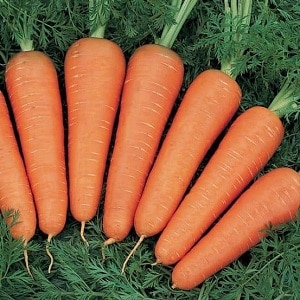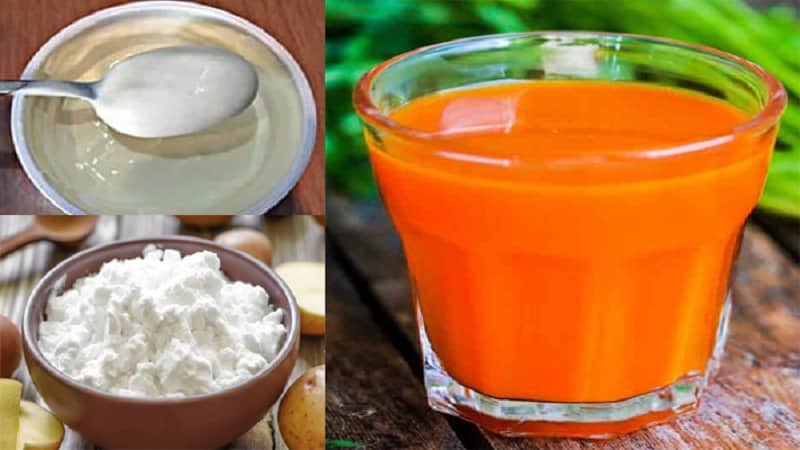How much starch is in carrots?
Carrots are one of the most popular root vegetables in our latitudes. It is impossible to imagine first and second courses, fresh salads and holiday snacks without it. Nutritionists recommend including the product in your daily diet to replenish vitamins and minerals.
In this article we will talk about carrot starch, its amount in the product and its benefits.
Is there starch in carrots?
Are carrots a starchy vegetable or not? Yes she is one of the starchy vegetables, along with beets and potatoes. The latter contains 10-15 g of starch per 100 g. 100 g of fresh carrots contain 1.43 g of starch, which is 8% of the daily requirement. After heat treatment, its amount is reduced by half.
In the gastrointestinal tract, starch undergoes hydrolysis and is converted into glucose - one of the fastest sources of energy for the brain. Gray matter consumes about 20% of calories received. There are no reserve reservoirs for storing this substance in the body, and for normal functioning the brain must absorb 120 g of sugar per day. Accordingly, to replenish glucose reserves, it is necessary to obtain this glucose - for example, from fresh vegetables or fruits.
 Starch is broken down into individual glucose molecules, which turn into fat. But not all starch behaves this way. The most beneficial is the resistant, or resistant type, found in raw vegetables. It penetrates unchanged into the large intestine, is not absorbed into the gastrointestinal tract and is not harmful to the human body.There it serves as a breeding ground for beneficial bacteria.
Starch is broken down into individual glucose molecules, which turn into fat. But not all starch behaves this way. The most beneficial is the resistant, or resistant type, found in raw vegetables. It penetrates unchanged into the large intestine, is not absorbed into the gastrointestinal tract and is not harmful to the human body.There it serves as a breeding ground for beneficial bacteria.
Heat treatment converts resistant starch into regular starch., which is then deposited on the sides as a fat layer.
The photo shows a productive carrot hybrid Canada f1.
Incompatible products
Nutritionists do not recommend combining starchy foods with protein foods, even contrary to popular belief that meat should be eaten with vegetables.
This is due to the peculiarities of starch absorption:
- alone, carbohydrates are absorbed within 3-4 hours;
- the ideal environment for digesting carbohydrates is alkaline, proteins are acidic;
- animal proteins take longer to digest than carbohydrates;
- excess glucose is transformed into fat.
Adherents of a separate type of nutrition do not recommend combining meat and cooked carrots in one plate due to the difficulties encountered in the process of simultaneous digestion of such products.
Interesting. The European Union adopted a special resolution in 1991, according to which carrots became a fruit. It's all because of Portuguese carrot jam, exported to EU countries. European legislation provides for making jam and preserves only from fruits, and Europeans did not want to be deprived of this delicacy.
Ideal food combinations
To ensure that your meals are not only tasty, but also healthy, carrots are better to combine:
- with starch-containing products: rice, wheat, spelled, buckwheat, millet, bulgur, corn, potatoes;
- with fat-containing products: cream, vegetable and butter, cheeses, sour cream, nuts.
The body receives maximum benefit from eating fresh carrots.
The recommended daily intake of carbohydrates is 30 g.It is quite difficult to get it from one carrot; to do this you will have to eat about 2 kg of raw vegetable.
Application of starch
You won't find carrot starch on store shelves.. Due to the scanty content in root vegetables, it is irrational to produce it. But it belongs to the same type as potato, which is used in cooking, cosmetology, and folk medicine.

Based potato starch sauces are prepared, it is added to thickening cream, vegetable and meat dishes to add thickness.
It is used in home cosmetology for preparing masks for face, body and hair.
In folk medicine, the product is used for treatment of stomach ulcers and alcohol poisoning due to its enveloping properties.
Reference. Starch is used to care for pets - applied to the fur and combed with a brush.
In the food industry, starch is included in the composition noodles, marmalade, chips, sausages, quick soups, jelly, mayonnaise, ketchup, confectionery powder creams and dough. It is used to produce gluten-free products. The powder is widely used in Asian cuisine.
Starch is added as a leavening agent in the production of cosmetics and medications in tablet form and a number of solutions for intravenous infusions.
Technical applications are quite wide: The powder is used to create adhesive for wallpaper, adhesive tapes, and fabric sizing products.
Starch is used in everyday life:
- as a powder for babies;
- for starching clothes;
- as a streak-free window cleaner;
- for polishing silver to a shine;
- to remove grease stains from textiles;
- to soothe irritated skin after insect bites and sunburn;
- to get rid of unpleasant shoe odors.
Homemade mask instead of Botox
The product smoothes out shallow wrinkles and tightens the skin of the face.
To prepare the mask you will need 1 tbsp. l. starch and 200 ml boiling water. The powder is poured with hot water, mixed and left to cool completely. Then add 5 tbsp. l. fresh carrots, 1 tbsp. l. fat sour cream and stir until smooth.
The mask is applied in a thin layer 5-6 times: applied one, left to dry, applied a second, and so on. The mask is left on the face for 15 minutes and washed off with warm water. The result will appear after 10 regular sessions. Frequency of use: 2 times a week.
Firming mask
The mixture has a noticeable lifting effect, tightens the skin, makes it smooth and elastic. Kefir and starch are mixed in equal proportions with whipped egg whites. The composition is applied to a cleansed face for 15 minutes, then washed off with cool water. Frequency of use: 2-3 times a week.

Whitening mask
A mixture of starch and lemon juice in equal proportions can lighten freckles. and age spots. The mask is applied to clean skin for 10 minutes and washed off with warm water. The effect is noticeable after the first use. The frequency of procedures is 1-2 times a week.
Kissel for stomach ulcers and gastritis
Starch-based jelly is taken in liquid and jelly-like form.. To prepare drinking jelly, take 1 tbsp. l. starch per 1 liter of cold water, jelly - 3 tbsp. l. per 1 liter of liquid.
The starch is stirred in water, then poured into boiling syrup from berries, fruits or dried fruits, brought to a boil and cooled.
Recommendations from nutritionists
To ensure that eating carrots in raw and heat-treated form brings only benefits, nutritionists recommend:
- Cook carrots quickly to preserve vitamins, minerals and starch.
- Include fermented vegetables (sauerkraut) in your diet to normalize healthy intestinal microflora and better digestion of starchy foods.
- Use high-quality butter (at least 82.5% fat) and unrefined vegetable oil (olive, sesame, flaxseed, pumpkin) along with carrots.
- Consume more raw carrots whenever possible for healthy gums, teeth and digestive system.
- Drink fresh juice to prevent diabetes and growth retardation in children.
- Use orange vegetable for prevention and as an aid in the treatment of arthritis. Beta-carotene and vitamin A help relieve inflammation in joints, ligaments and muscles.
- Season carrot salads with sour cream for better absorption of fat-soluble vitamins D, E, K.
Conclusion
Carrots do not contain much starch compared to potatoes - only 1.43 g per 100 g of raw product. Nutritionists recommend eating fresh root vegetables because they contain resistant starch, which is safe for health. Freshly squeezed juice can be drunk even if you have diabetes - synthesized glucose does not cause a sharp jump in blood sugar.
For better absorption of starch, carrots are combined with starchy foods (cereals, potatoes, legumes), vegetable and butter, nuts, but combinations with meat are avoided.